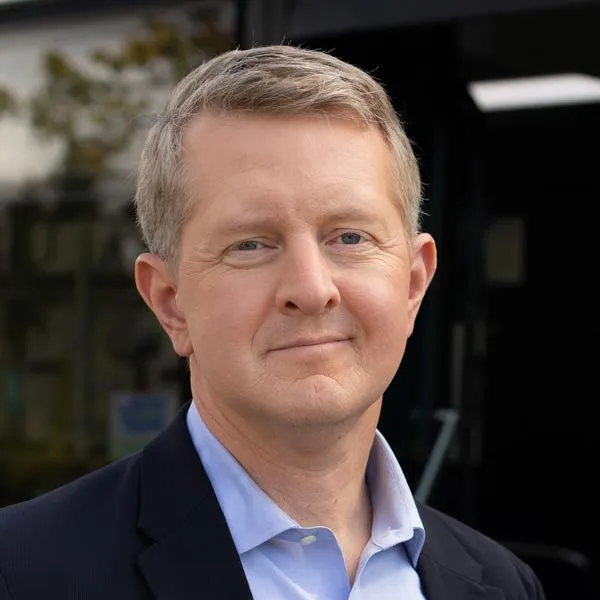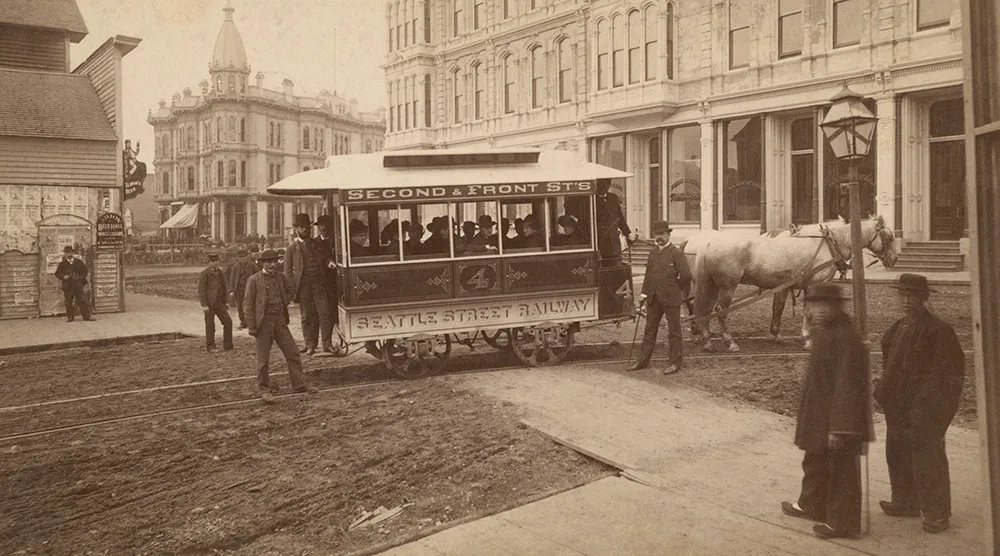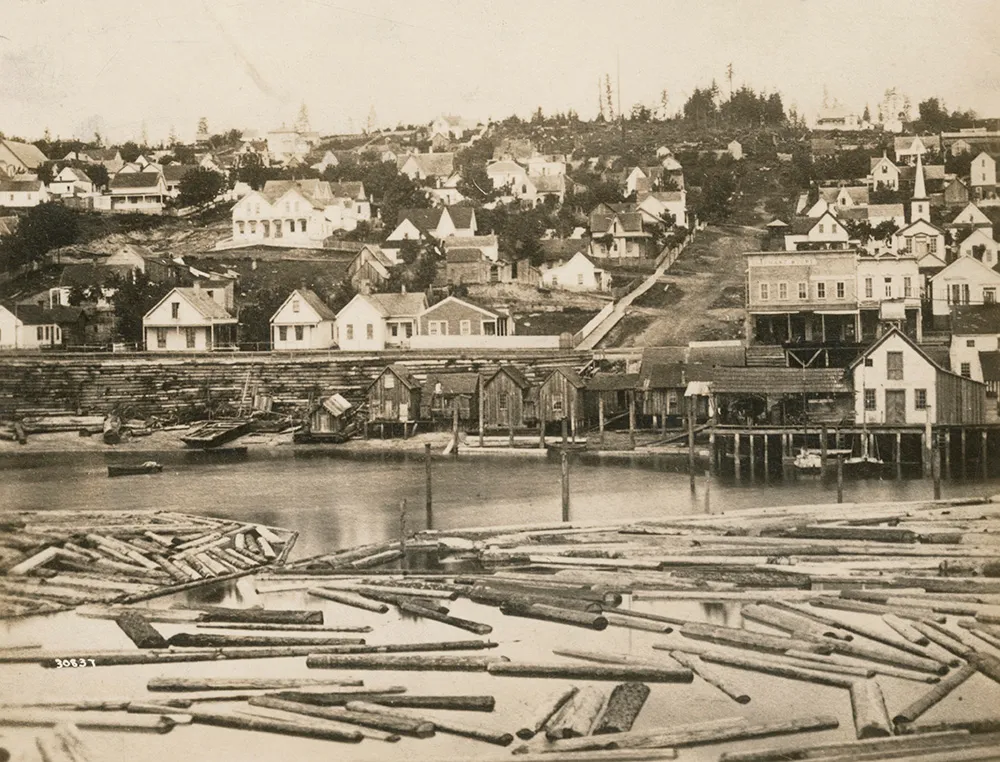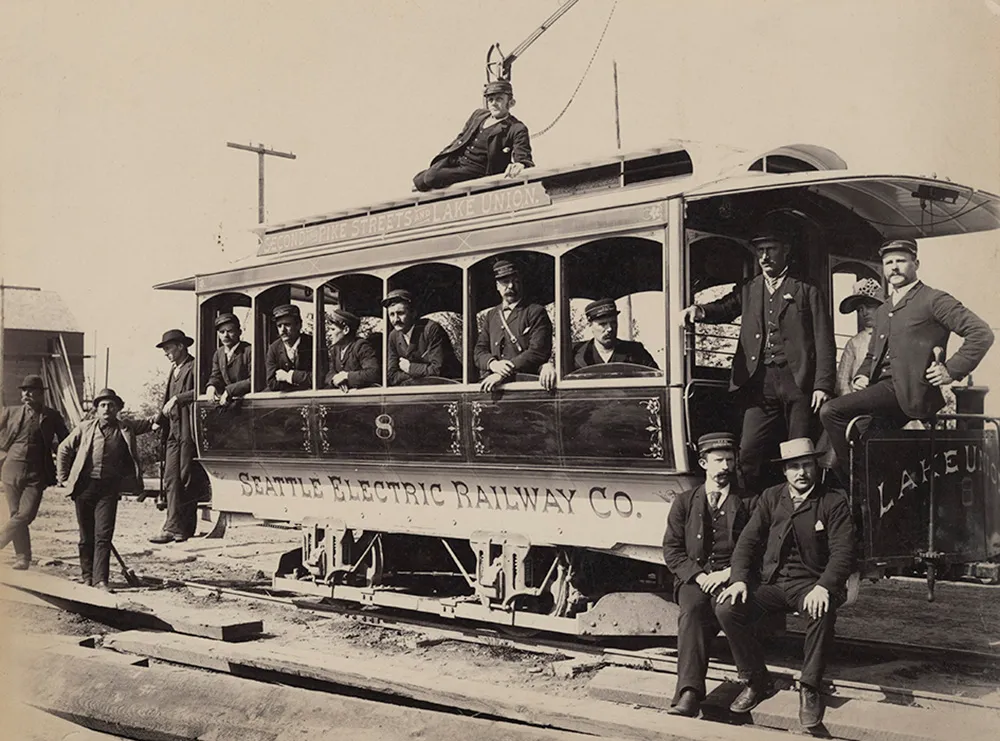The Transit Effect

Join “Jeopardy!” host Ken Jennings in a series on how transit shapes communities.
Ken Jennings, the host of “Jeopardy!” and the show’s record-breaking champion, has used public transit around the world. As a college student at UW, he regularly took the bus home to visit his family in Edmonds. Now, he’s partnering with Community Transit to explore how transit influences infrastructure, economies, culture, and opportunity in The Transit Effect, a seven-part video series.
Episode 2:
The Route to Prosperity
In episode 2, learn how transit does more than move people — it moves our economy forward.
Why should you care about public transit?
Even if you never ride a bus or train, the transit systems around you influence how your community is built and how your day unfolds. It’s a force that shapes where we live, how we work, and who we connect with. To better understand how future transit investments might affect your world, there’s no better teacher than the past.
From Canoe Routes to Streetcars
Since time immemorial, Coast Salish peoples — including the Duwamish, Snohomish, Suquamish, Stillaguamish, and Tulalip — have lived, traveled, and traded across the lands and waters of the Pacific Northwest. Their culture and traditions are deeply connected to systems of movement: ancestral waterways navigated by canoe, footpaths shaped by the land, and seasonal gathering places that sustained community. Their routes and waterways were the region’s first systems of transit.
By the mid-1800s, newcomers had begun reshaping the landscape of the Seattle area to support industry, trade, and colonization. Vast forests and waterways attracted newcomers. A booming logging industry, fishing routes, and steamship service all fueled Seattle’s transformation into a bustling port town.

This photo was taken in September 1884, opening day of the Seattle Street Railway. Mayor John Leary and invited guests are seated in the horse-drawn streetcar at the intersection of Mill Street (Yesler Way) and Second Avenue. Photo credit: Museum of History & Industry, Seattle
Seattle’s first horse-drawn streetcar opened in 1884, connecting the downtown core — what is now Pioneer Square — with nearby emerging residential neighborhoods.
The Seattle Spirit
The region’s abundant forests and multiple mills made wood the go-to building material for a rapidly growing town. Buildings, sidewalks, streets, and even parts of streetcar tracks were constructed from wood. That changed on June 6, 1889, when an overturned glue pot in a carpentry shop sparked a fire that quickly spread through the densely built downtown. Dense, flammable construction was tinder for the roaring fire. Low water pressure and a lack of firefighting manpower made the flames impossible to contain.

This photograph was taken in 1880 looking east up Columbia Street from Yesler Wharf when Seattle was a booming lumber town. The logs in the water are awaiting milling. Photo Credit: Museum of History & Industry. Photo credit: Museum of History & Industry, Seattle
In less than a day, the Great Seattle Fire turned more than 25 city blocks of Seattle’s central business district to ashes. Most of the original horse-drawn streetcar infrastructure was destroyed. But the fire didn’t stop progress. Instead, it sparked it.
In the months that followed, the city established a fully-paid professional fire department and rebuilt with brick and raised streets to fix chronic flooding and water pressure problems. These changes created more level streets, paving the way for transit expansion. Just three months later, the city debuted its first electric streetcar — faster, cleaner, and more reliable than the horse-drawn lines it replaced.

In this 1890 photo, a group of Seattle Electric Railway and Power Company motormen pose around Streetcar #8. The photo was probably taken to commemorate the start of service from downtown to Lake Union. Photo Credit: Museum of History & Industry, Seattle taken by Frank McClellan.
The fire helped launch the era of modern transit in Seattle — and reinforced a lasting belief in infrastructure as a foundation for growth and progress. The legend of “The Seattle Spirit”— the belief that no setback is too great to overcome — was born from the ashes.
Through the Panic of 1893 — a nationwide economic depression — Seattle’s early infrastructure investments helped the city rebound. Seattle’s streetcar network more than quadrupled in size over two decades — from 48 miles of track in 1892 to over 200 miles by 1915. The growing system connected neighborhoods like Capitol Hill, Ballard, West Seattle, and Rainier Valley. Transit molded those neighborhoods into what they are today.

A Madison Street Cable Railway car rides wooden cribwork during the Third Avenue regrade, c. 1907. Behind it is the Seattle Theatre with the Lincoln Hotel visible uphill. Photo Credit: Museum of History & Industry, Seattle.
History is rooted in both innovation and displacement. Telling it honestly means acknowledging both. The growth of early infrastructure displaced ecosystems and Indigenous communities whose presence long predates the city. As we invest in more equitable, sustainable mobility today, we have a chance to reflect, to remember, and to build with care, carrying these lessons of the past forward.
Transit & Today’s Economy
In the turbulence of today’s economy, transit investments provide a steadying force. Locals don’t have to look very far back to see how new public transit options transform communities. Link light rail service opened in Lynnwood in August 2024, bringing faster regional travel and major changes to surrounding communities. While the timeline and cost of light rail’s expansion have drawn scrutiny, the project represents one of the region’s most ambitious investments in future mobility. And those investments are fueling real economic growth. According to the American Public Transit Association (APTA), every dollar invested in public transit returns five times that amount to the local economy.
Community Transit is making it easier than ever to connect to light rail stations and get around locally with a bold plan to increase service by 32% by 2029.
Behind these new transit projects are jobs — the kind that build careers, not just paychecks. Public infrastructure projects are often covered by union contracts that ensure fair wages and strong workplace protections. For example, the Lynnwood Link Extension was built under a labor agreement that prioritized hiring union workers, supported apprenticeship programs, and opened doors for women, veterans, people of color, and people from low-income households in the trades.
In Washington, union workers earn about 7% more than non-union workers These jobs are also more likely to come with health coverage, retirement benefits, and safer working conditions — contributing to healthier families and stronger communities. At Community Transit, many employees are represented by unions, including drivers and maintenance staff.
National reasearch from APTA estimates that for every billion dollars invested in public transit, 50,000 jobs are created. By that measure, the Lynnwood Link Extension’s $3.26 billion budget could support roughly 162,000 jobs — and that’s just the beginning. That figure doesn’t include the economic boost from Community Transit’s expanded services or the many infrastructure investments that light rail in Lynnwood has helped catalyze. As light rail expands north to Everett, even more job growth is likely to follow.
We’re already seeing momentum build. The launch of Community Transit’s Swift Orange Line and the extension of the Swift Blue Line are major steps toward a more connected regional network. Public transit doesn’t just move people — it moves the economy. National research shows that 87% of transit trips directly support local businesses by connecting riders to employment, retail, and entertainment.
One study commissioned by the City of Lynnwood projects that by 2030, the Lynnwood light rail extension will help create an additional 4,400 jobs within walking distance of Lynnwood City Center and Mountlake Terrace stations. And the economic benefits are felt close to home for homeowners. National studies — including data from the Seattle metro area — show that properties within a half-mile of public transit can see values rise by up to 24% compared to those farther away, delivering a tangible return on investment for entire neighborhoods. All of these changes add up to something bigger: better access to opportunity and more ways to get where you want to go.
The Road to Opportunity
Public transit access is especially critical for people who rely on it every day. In Washington, 7% of households don’t have access to a car. For households earning less than $35,000 a year, that number climbs to 19%, limiting the ability to reach jobs, school, healthcare, and other daily needs.
Many of the neighborhoods with the least access to transportation today are the same ones that were systematically excluded from investment decades ago. In Washington state, Black households are more than twice as likely as white households to lack access to a car (14% compared to 6%).
Washington state is investing in changes that can help reduce some of these systemic inequities Move Ahead Washington — a 16-year, $17 billion transportation package passed in 2022 — includes dedicated funding to close transportation gaps in overburdened and historically excluded communities. Grants for Tribal transit, safe streets in underserved neighborhoods, and oversight from the state’s Environmental Justice Council are just a few examples. One change with big impact: kids and teens 18 and younger now ride public transit free, opening the door to jobs, education, and opportunity.
“When young people can ride transit for free, it’s more than a ride — it’s access. For many, transportation is a huge barrier to participating in meaningful and formative activities. For families and households, transportation is the biggest expense after housing,” says Community Transit’s youth engagement specialist Natalie Lawrence, who helps local youth understand their transit options.
“Free transit for youth means getting to school, jobs, sports and tutoring, without the stress of how to pay for it. It opens doors to opportunities, keeps young people engaged in their communities, and removes a major cost barrier.”
That kind of access doesn’t happen by accident — it happens because communities choose to invest in it.
Who Pays for Community Transit? (Spoiler: Not Your Car Tabs)
Community Transit is funded primarily by local sales tax, with support from state and federal grants, and a smaller share from fare revenue. Every time you shop in Snohomish County, you’re helping keep buses running and expanding service.
And no, your higher car tabs aren’t part of our funding. A portion of the Motor Vehicle Excise Tax goes to Sound Transit — but only if you live in parts of Snohomish, King, or Pierce counties served by Sound Transit. Community Transit doesn’t receive any of that funding.
Community Transit projects $278 million dollars in its 2025 budget to support bus, vanpool, DART, and Zip operations. An additional $60 million is expected to support capital purchases such as buses and other infrastructure to expand our services and keep our assets in a state of good repair. Community Transit owns a fleet of more than 250 buses, which represents a significant effort to maintain and operate.
The chart below focuses on the projected $278.1 million operating revenue — our most flexible funding source, used for the day-to-day work of running transit and other services. The remaining revenue comes from grants and dedicated funds earmarked for specific projects and large purchases such as vehicles that need replacement. However, we spotlight the general fund here because it tells the clearest story about our core operations — and how your tax dollars support the services you rely on every day.
Where Community Transit’s Funding Comes From
Major Source of General Fund Revenue: $278.1 million (2025 budget)
- 75% comes from the sales tax you pay in Snohomish County.
- 5% comes from state and federal grants that help fund service improvement, paratransit service, and zero-emission projects.
- 4% comes from the fares people pay when riding our services.
- 8% comes from our contract with Sound Transit for which we provide some express service.
- 8% comes from other sources, including advertising revenue, interest income, and city partnerships.
Fares make up a small share, but every trip still helps — by boosting ridership, supporting service planning, and showing community demand. And every dollar helps support local jobs — drivers, mechanics, service planners, and support staff.
Transit Moves Us — Together
Since the region’s first canoe routes, how we travel has been central to our cultures and communities. From young riders getting to school to union workers building tomorrow’s infrastructure, the journey shapes who we become. And the future we want happens when we choose to invest in it — together.
Want to see the transit effect in action? Ride with us.
Join the Conversation
Stay tuned for upcoming episodes as we continue to explore The Transit Effect and learn about public transit’s role in opportunity, sustainability, accessibility, and beyond. Subscribe and share your thoughts on our YouTube channel.


